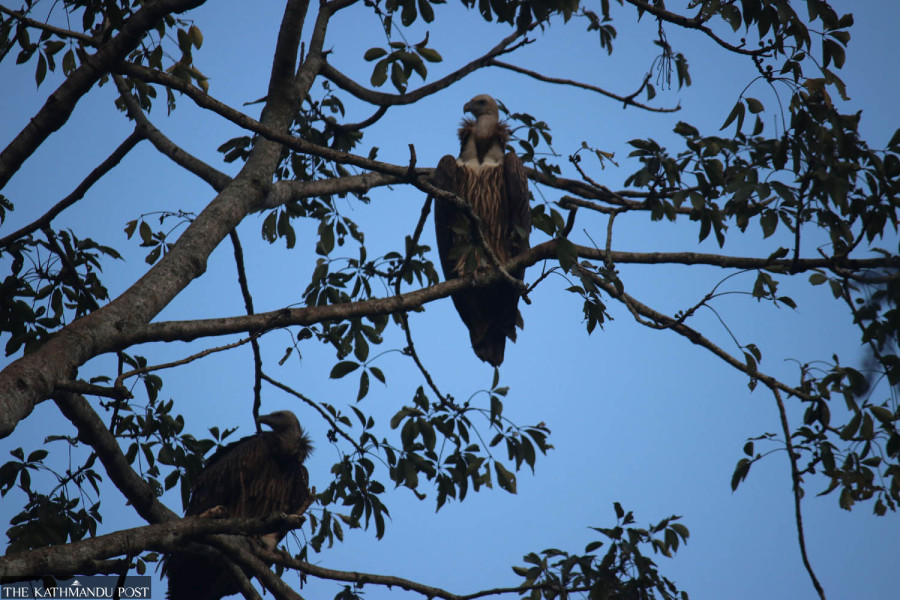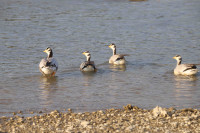Lumbini Province
Palpa’s Khaireni community forest is teeming with vultures
Conservationists credit the Diclofenac ban for the revival after decades of dwindling numbers. This area was declared ‘vulture conservation zone’ in 2001.
Madhav Aryal
Thaneshwar Aryal, aged 76, of ward 8 of Anpchaur of Rampur Municipality recalls seeing hundreds of vultures in the nearby Khaireni forest area some four decades ago. Flocks of various species of vultures perched on tall trees. They took shelter in the old Simal (kapok) trees in the forest.
“But their number dwindled to 20-30 some two decades ago. Recently, however, the vulture population has been thriving in Khaireni community forest,” said the septuagenarian who is keen on vulture conservation.
The Khaireni forest area was declared a community forest in 1992. It is estimated that Khaireni forest was the habitat of around 1,000 vultures in early 1990s. The vulture population dwindled after a few years mainly due to Diclofenac used in treating livestock.
The forest authorities and local people carried out a series of conservation efforts to protect the Khaireni forest and turn it into a major habitat of vulture and several other birds and animals. The forest area was declared a ‘vulture conservation zone’ in 2001. The forest users imposed a ban on collecting grass, firewood and controlled cutting down trees and hunting.
“The conservation efforts finally paid off. The vultures started making the Khaireni forest areas as their habitats in recent years. The vultures make 30 to 45 nests in the forest area in a year,” said Rukmangat Aryal, a local and user of Khaireni community forest. “We are now working to develop Khaireni forest as a major destination for eco-tourism and vulture conservation area.”
According to conservationists, six different vulture species— Vulture (Seto Giddha), Slender-billed vulture (Sano Khairo Giddha), White-rumped vulture (Dangar Gidda), Red-headed vulture (Sun Giddha), Himalayan Griffon (Himali Gidda) and Cinereous Vulture (Raj Gidda)—are sighted in the Khaireni forest area in the recent time.
Khaireni community forest has managed food for vultures over the past nine years. “The community forest started managing carrions in 2015. Carrions are kept in a fenced area in the forest where the vultures can eat their foods without any disturbances,” said Chhaya Chandra Pangeni, chairman of Khaireni community forest.
The Kaligandaki river flows through the community forest. According to Pangeni, the river flows in the area by making an almost complete circle. So the dead animals it carries are dumped on the river banks which serve as food for the vulture.
Khaireni forest, as conservationists argue, has been a safe haven for vulture conservation. “The forest area is far from human settlements so the birds and animals are not directly affected by human activities. The area can be turned as the country’s major habitat of vultures,” said Khil Bahadur Tamang, information officer at the Division Forest Office in Palpa.
As per the recent study of the Division Forest Office, Khaireni community forest is the habitat of 105 species of birds, 13 species of mammals, eight species of reptiles and 30 species of butterfly. A total of 34 vulture’s nests were found in the forest area last year.
The community forest users’ group and the local people are elated with the increasing vulture population in the Khaireni forest area. They are hopeful to make the area as the major destination of eco-tourism in the country. The community forest constructed a vulture park, entry gate and foot trail to move around the forest and watch birds, animals and vegetation.
Nine of the total 23 vulture species found in the world are recorded in Nepal. Four species—white-rumped vulture, slender-billed vulture, red-headed vulture and Indian vulture—are listed as critically endangered. The Egyptian vulture is listed as endangered and three species—bearded vulture, cinereous vulture and himalayan griffon— are listed as near threatened.
The Himalayan, Egyptian, and bearded species of vultures make their nests on cliffs, whereas the species of white-rumped, slender-billed, and red-headed vultures build their nests in trees. Among the nine species found in Nepal, only these six build their nests and lay eggs in Nepal, whereas the other three do not.
The white-rumped vulture is the smallest among the nine species found in Nepal. Its population dwindled during the 1990s. Several researchers have linked the use of Diclofenac, an anti-inflammatory drug used in treating livestock, to the decline. Studies have shown that vultures feeding on carcasses of livestock treated with this drug suffer kidney failure and die within a few days. Since the government banned the production, sale and use of Diclofenac in 2006, the population of white-rumped vultures has gradually increased.
According to experts, the vultures also help in controlling the spread of epidemics like cholera, rabies, plague, and anthrax by keeping the environment clean. It is crucial to protect vultures, as they play an important role in ecological harmony and making the food chain balanced and dynamic.




 5.44°C Kathmandu
5.44°C Kathmandu














